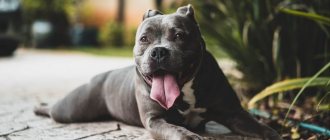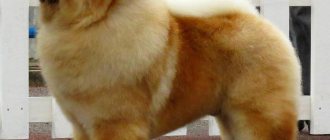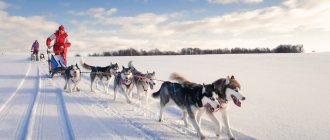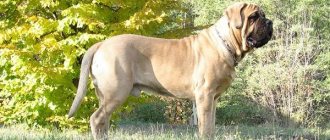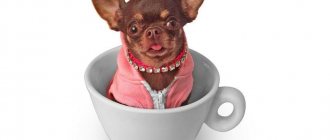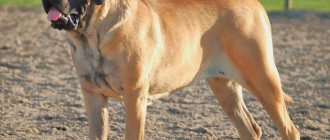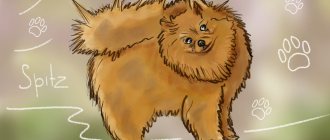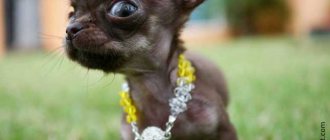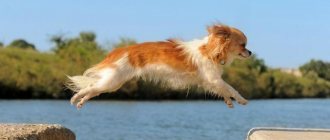Do you think that all dogs understand humans and learn quickly? Alas, no - there are breeds that have difficulty remembering commands and often do strange things. Conventionally, they can be called stupid, but often the point is not in mental abilities, but in a fair amount of stubbornness or psycho-emotional characteristics (for example, increased excitability or fearfulness, when in a fit of “passion” the animal becomes uncontrollable).
- 2 Afghan Hound
- 3 Chow chow
- 4 Husky
- 5 Beagle
- 6 English Bulldog
- 7 Mastiffs
- 8 Toy Terrier
- 9 Photo gallery: other dog breeds considered not very smart
- 10 Video: stupid dogs
Basset Hound
Calm and sociable dogs, friendly to other animals and children.
Like many other “stupid dogs,” Bassets can be stubborn, slow, and pay more attention to the amazing smells around them rather than to their owner’s commands. For a treat, they will do what you want them to do. However, if you have nothing to offer your basset, he will “forget” the learned command. Don't be fooled by the Basset Hound's sad eyes; behind them lies a strong, inquisitive and unwilling personality.
Rottweiler
This powerful service dog commands respect at first sight. She is ready to make self-sacrifice for the sake of her owner's life. The ancestors of modern Rottweilers lived in ancient Egypt and Babylon. Dogs helped people hunt, guarded their homes, took part in military operations and at the same time were loyal friends.
A courageous, strong, but slightly lazy Rottweiler agrees to serve a person faithfully at the present time. This dog should be trained from an early age. From the first words he understands what is required of him, but only a strong-willed and calm owner will carry out commands unquestioningly.
In the family, the Rottweiler behaves like a peace-loving goofball and does not show aggression at all towards children and other animals. But as soon as he suspects danger, he turns into a real devil with whom it is better not to argue.
Basenji (African non-barking dog)
Basenji Basenji is a rare breed in European countries.
It was bred in Africa for the purpose of hunting and pursuing prey. The pet copes with its direct responsibilities perfectly, but does not shine with a sharp mind. Basenjis are not prone to training; they have a hard time accepting and remembering new information. By nature they are stubborn and self-willed, they are in no hurry to carry out commands, expecting motivation in the form of treats. To properly raise such a dog, daily training is necessary - in the absence of training, it will quickly forget everything that the owner taught. Outside of hunting, such pets are lazy and do not bother themselves with brain activity, preferring to passively and mindlessly observe what is happening around them. Ideal for living in an apartment - Basenjis do not bark and are extremely clean.
Shar Pei
Due to the peculiarities of the Shar Pei's skin, namely the folds, the dogs are popular in many countries around the world. Shar Peis are distinguished by courage, strength, excellent watchdog and security qualities, self-confidence and devotion to their owners.
And if a voice is needed, it will be used if necessary to warn the owner about something important.
The dog has a sharp mind, intelligence, and goodwill towards children. We cannot neglect the fact that the Shar Pei is initially aggressive by nature, so its early socialization, demanding training (without rudeness and violence) is required and the pet will develop its best qualities.
Shar Pei height is 45-50 centimeters, weight varies from 18 to 25 kilograms, life expectancy is 9-10 years.
Shar Pei requires active long walks: the more energy he splashes out on the street, the calmer he will behave at home.
Mastiff
You wouldn't dare say "stupid dog" directly to a big, muscular mastiff's face.
However, (behind their backs) we admit that a high level of activity and ease of training are not among the hallmarks of this breed. Due to the breed's enormous size and good guarding qualities, it is important that the mastiff owner begins training and socialization of his pet at an early puppy stage. And then the mastiff will become a respectable and formidable protector of the whole family.
How to test your pet's intelligence
To test intelligence on a traditional scale, you will have to spend a lot of time, and it is advisable to start in puppyhood, when training the dog is just beginning. There is nothing complicated here - you need to measure how many times one command needs to be repeated before the dog can carry it out correctly. The fewer repetitions there were, the higher the pet’s intelligence.
On a note! An easy way to test a dog's intelligence is to throw a blanket over him. Smart dogs will quickly get out from under it, but stupid ones will panic and twitch randomly.
The same can be said about how often a dog will execute a command correctly the first time. Ideally, this should be 90-100% of cases, but a figure of 70-80% is very good.
Beagle
These dogs love to follow where their scent leads, which can sometimes lead to trouble. The Beagle's cheerful and affectionate nature, combined with its deceptively sad look, may make you think that it is the perfect pet toy. But that's not true. Beagles are extremely active and purposeful dogs, they have a difficult character and cannot resist the desire to explore the world. Because of their unique sense of smell, this breed helps police officers search for explosives.
Shih Tzu
At first glance, dogs of this breed resemble plush toys, which is not so far from reality. These are small animals with luxurious fur, long flowing strands, different colors (most often light or reddish) and a cute face. The breed is classified as decorative and is extremely difficult to train, which is due to the long history of its origin.
Shih Tzus were bred for beauty, not intelligence.
Shih Tzus were bred specifically for representatives of royal families back in the Ming Dynasty, and their main function was to recline with a languid look on pillows, calmly enduring the affection and hugs of their owner. They did not require the ability to follow commands and obey, so modern descendants of the royal Shih Tzu are not distinguished by high intelligence. But they are great as a sweet and kind pet, they are practically non-aggressive, and are great for those who want to have a living, beautiful toy and agree to look after it.
German Shepherd
The breed was developed at the beginning of the twentieth century from representatives of Old German Shepherds, which were once herding dogs. During the Second World War, the German Shepherd was used as a patrol dog, orderly, and bloodhound.
Beautiful and large dogs will become faithful companions for those who are ready to work with them
Nowadays, the German Shepherd has become one of the most popular breeds thanks to its participation in more than a hundred films: “Come to me, Mukhtar”, “K-9”, “I am Legend”, etc. The films accurately describe the best aspects of this breed:
- emotional stability;
- unquestioning obedience;
- inquisitive mind;
- fearlessness and nobility.
The German Shepherd is not born dutiful and obedient. To cultivate these qualities in a dog, you need to make a lot of effort, including methodically working with a dog handler. However, not all breeders understand this. According to statistics on dog attacks on people from 1982 to 2014, the German Shepherd ranks third, which indicates a high level of aggression in this breed.
The Shepherd requires control and training from the first days of life in your home
Breed Features:
- A universal purpose dog: guard, watchman, companion.
- He considers himself second only to the owner and elevates himself above the rest of the family. Only one person will listen.
- Neutral towards children. May not get along with another dog or cat.
- Requires careful training, otherwise it becomes aggressive and uncontrollable.
Height and weight: 55–65 cm, 25–40 kg.
Life expectancy: 13 years.
Average cost: $200 (RUB 12,000).
Pekingese
Unlike many breeds that were originally conceived as working dogs and later became companions, the Pekingese from the very beginning played only one role - as a human pet. Intelligence has always ranked last on the list of qualities of this breed. But Pekingese are very beautiful, cheerful, friendly and can be kept in a small apartment.
Australian heeler
A dog you can trust in everything. The homeland of this wonderful breed is Australia. Local residents bred them as herding dogs and they had no equal in this matter. Hardworking, balanced, flexible healers have excellent mental abilities. It is this quality that brought them into the top ten dog leaders on the planet.
The Australian Heeler is an infinitely faithful and devoted dog, which is an ideal guard. They are obedient and well trained. These dogs are cheerful and active. Shaggy Australians quickly remember commands and do it with great pleasure.
A nanny dog is the second purpose of this breed. Having absorbed the shepherd's instinct with their mother's milk, they will never offend the child and take care of him, like real educators. For those people who truly love them, they are ready to give their dog’s heart forever.
Yorkshire Terrier
One of the smallest dog breeds in the world is also one of the most playful.
Yorkies are very naughty and active, and their small size allows them to get into places in your home where they clearly shouldn't be. They can even sneak under a person sitting on the sofa. Many Yorkie dogs love to mark things in the house, even if they do their “business” outside. These dogs are also very playful, constantly getting underfoot and trying to protect the owner from any threat, even if it is several times larger than a Yorkie.
CAVALIER KING CHARLES SPANIEL
- Dog breeds / small / for apartments / do not bark
Photo: Bigandt_Photography/Getty Images
Cavalier King Charles Spaniels are not known to bark. But this happens if the dog craves attention or feels neglected. The Cavalier King Charles Spaniel may bark due to anxiety, fear, loneliness or separation anxiety.
MORE DETAILS
Add to cart
Quick view
Compare
Close
CeramikArt ceramic box for storing dog treats white
450,00 ₽
Add to cart
Quick view
Compare
Close
Ceram bowls in der Trixie black
2 850,00 ₽
SHARPEI
- Dog breeds / medium / smart / for apartments / guard / do not bark
Photo: zokov/Getty Images
Shar Peis bark very rarely. This is an ideal choice if you prefer a calm breed. Shar Peis are a strong, loyal and loving breed of dog. These "Chinese" maintain a zen-like calm unless they sound the alarm about a potential threat.
MORE DETAILS
Ekaterina Varnava, Olga Orlova, Michelle Pfeiffer published touching zoo photos on Instagram
JAPANESE CHIN
- Dog breeds / small / for apartments / do not bark
Photo: Niconic_Photography/Getty Images
The Japanese Chin is not prone to barking. This is a family breed, calm and pleasant, and gets along well with children. They are often compared to cats because chins love to rest on their owner's lap. These dogs may bark from separation anxiety or if they have been neglected.
MORE DETAILS
GERMAN DOG
- Dog breeds / large / for protection / guard / do not bark
Photo: Earl-Wilkerson/Getty Images
Great Danes are a breed of gentle giants known for being highly protective of their home and loved ones. This is one of the quietest breeds. They rarely bark unless there is a good reason: to warn of danger, for protection, to greet, or out of boredom if they are ignored or left alone for too long.
MORE DETAILS
Add to cart
Quick view
Compare
Close
Hunter dog harness Tripoli nylon St. pink, reflective
850,00 ₽
Add to cart
Quick view
Compare
Close
DARELL Synthetic reflective collar “ECO-LUMI” 20mm 32-41cm
200,00 ₽
Bloodhound
The Bloodhound “sees” the world primarily with its extremely sensitive nose. These dogs are difficult to train because they are constantly distracted by all the smells around them. They also have a ton of energy, stubbornness and determination, and are absolutely unstoppable once they get on the scent trail. It is unlikely that you will be able to force a Bloodhound to do anything against its will. But on a large plot outside the city, where the dog can move freely, your pet will be happy, cheerful and satisfied with life.
Correcting puppy behavior
Correcting a puppy’s behavior usually happens quickly and without unnecessary difficulties. If the dog has no moral injuries, has not been subjected to physical abuse and wants to learn, it is enough for the owner to choose the right motivation.
Correcting the behavior of a small puppy is easier because the pet reacts sharply to your emotional mood. There are no contraindications to using treats, but it is better to follow the order - two praises and one treat.
If you do not have the desire or opportunity to contact a dog trainer, you can teach your pet basic commands yourself. During the training process, an interpersonal bond will be established between you and the puppy. In addition, the baby will learn to understand you by facial expression, tone of voice and posture.
Russian greyhound
These dogs with amazingly beautiful silky hair are independent freethinkers.
They can also be extremely stubborn, so training a greyhound is an exercise in patience. Frequent but short training sessions are best for these dogs rather than hour-long sessions. At home, they are usually very well-mannered, calm, clean and very affectionate.
What to do with a disobedient stupid dog, puppy, how to raise: training methods
Owners themselves make mistakes by raising their pets incorrectly. This is where failure to follow commands, stubbornness, and inappropriate behavior begins. It's all the owner's fault.
What to do with a disobedient stupid dog, puppy, how to raise, training methods:
- The wrong actions of the dog cannot be ignored . Under no circumstances should you follow the dog's lead. Very often dogs behave like dominants and do what they want, considering themselves the leader of the pack. The owner needs to constantly show and tell that he, and not the dog, is the leader in the house, setting boundaries. Under no circumstances should even minor miscalculations or failure to follow commands be allowed.
- The dog should not rest on the bed or in a chair. In the natural environment, only the leaders can sleep at higher elevations. Therefore, under no circumstances allow your pets to do this.
- Do not allow the dog to growl at someone in the household . He should be punished after showing aggression towards one of the family members.
- Do not allow your dog to be in the kitchen during family dinner or lunch. Kick him out, feed him only after all family members have had dinner
- Ignoring some training rules . Not only the dog handler should be involved in training, but also all family members should adhere to a certain line of behavior that the specialist has built. The owner must reinforce all commands and train the dog even without the presence of a dog handler.
- Under no circumstances should you train your dog to perform several commands at the same time. Follow the rule of consistency.
Doggie
Siberian Husky
A beautiful dog, similar to a wolf, but gentle and friendly with almost all people.
Husky loves the outdoors and needs to travel every day. He is smart, but free-spirited and independent, which makes training a Husky a challenge. Very often, huskies run away from home, and with incomprehensible cunning they even manage to free themselves from their leash. And they can easily jump even over a high fence.
Leaving a husky alone without communication, physical and mental stress is a sure way to return to a house destroyed from walls to floors.
Chow chow
Chow chows may look like adorable teddy bears, but they are not always sweet and kind.
Created to be guard dogs, Chow Chows are serious, independent and fearless animals. They are strong-willed and stubborn, and also very strong, so an experienced dog breeder is needed for training. The Chow Chow is not the stupidest dog in the world, she just has her own mind. A well-bred Chow Chow dog is a noble, loyal and reliable companion.
Beagle
Hounds are highly valued for their unsurpassed sense of smell and wonderful character. Loyal and flexible, these creatures are able to win the favor of anyone. But for those for whom the defining quality of a pet is intelligence, it is better not to mess with hounds. Not everyone will be able to withstand attempts to train a pet with such abilities: skills that a retriever, shepherd dog or any corgi will develop within a couple of weeks, in the case of a hound will need to be developed much longer. It is completely useless to be angry with her: the animal will feel guilty, but will not be able to improve its performance even with the most diligent attitude to instruction.
Bulldog
This breed is known for its stubbornness.
English bulldogs are calm, and even lazy, but at the same time they are ruggedly elegant and very affectionate towards people. They are excellent companion dogs for the phlegmatic person. And French bulldogs are more temperamental than their English counterparts, friendly, do not require long walks and are ideal for busy people. Because of their lazy nature, stubbornness, and tendency to get distracted, bulldogs require longer training than other dog breeds. They are not the best guards for a private home, they are not service dogs, and they do not strive to obey commands in an exemplary manner, like, for example, a German shepherd. The Bulldog is an excellent family companion dog and don't expect much more from it.
Border Collie
The smart dog was specially bred with the indicated parameters. Among domestic dog breeds, border collies are the smartest! Confirmed by breed breeders, outside observers, dog handlers, and breeding establishments. Dogs have a number of advantages:
- medium size, allowing you to get a dog outside the city, in urban conditions;
- noticeable activity makes the owner mobile - important in modern society;
- the highest ability to learn will facilitate the process of training and education;
- life expectancy – 16 years;
- suitable as a gift for a teenager over 12 years old;
- gets along with the owner's family, children, animals, strangers;
- companion, pet, sheep shepherd in villages, villages.
Let us note complex nuances for the owner. You will have to constantly take care of your pet's fur. The coat is the pride of the border collie! You need to bathe your pet up to 4 times a year. If you are not ready to show mobility, play, run with the dog, walk at least a couple of hours a day - do not take a closer look at the described breed. Suitable for active people who love guests, sports, family walks, and outings.
Features of canine intelligence
People are accustomed to consider smart dogs those that are obedient and aware of what is required of them at a certain moment. This is convenient for a person, and he included in the concept of canine intelligence other criteria that form and at the same time limit this definition.
- Animal instinct , which allows an animal to demonstrate its skills determined by genetics. Such useful qualities that make an animal a good watchman, hunter, bloodhound or security guard. Instincts play an important role not only for professional activities - they influence obedience and the success of the socialization process.
- Adaptability to new conditions , the ability to behave adequately in any, including unfavorable conditions. This means adaptation to the owner’s family, the ability to ignore unwanted events, and a calm attitude towards other living beings. Experts call this skill adaptive intelligence, and it is not present in all canines.
Basenji
This African non-barking dog is known for its independence and aloofness.
Some people describe the breed as having cat-like qualities, and in fact many Basenjis paw-wash themselves like cats. Basenji dogs have earned a reputation for being "unmanageable," but in this case, ease of training is not always an accurate indicator of intelligence. On the contrary, these animals are smart, curious and playful. They have excellent hunting qualities and are still used for hunting in the Congo.
Training a Basenji can sometimes feel like taming a wild animal. They are vigilant and careful, and also fearless and very stubborn. You cannot educate them with a stick, only with patience and affection.
Afghan Hound
It can be said that these graceful dogs with luxurious long hair are ruled by the nose.
For this reason, Afghans are difficult to train because they don't look up, they look down. Dogs of this breed are not very interested in listening to or pleasing people. They are more interested in what smells around them and also want to chase anything that moves. At the same time, Afghans are very affectionate and kind animals. And the fact that they are in no hurry to obey the owner’s commands does not mean that the pet is unteachable. The Afghan Hound was bred for hunting. Often these dogs overtook a hunter on horseback and chased the animal on their own, without instructions from a person. Thanks to this, they developed an independent and persistent character. Give your Afghan the opportunity to show his hunting temperament and you will not find a better companion.
Not all scientists agree with the classification of the stupidest dogs from Koren's list.
“I don't think there are such things as smart dogs and stupid dogs. This is simply a return to the linear version of intelligence, as if intelligence is a cup of coffee that is more or less full. Different dogs are good at different things. And they are all geniuses in their own way,” says Brian Hare, an associate professor of evolutionary anthropology at Duke University in North Carolina.
Rating of stupid breeds
So who is at the bottom of the Koren scale? The sixth category of the intellectual rating includes breeds that require from 80 to 100 repetitions to learn a new command; only in 25% of cases such dogs are able to execute the command on the first serve.
It is interesting that Stanley Coren considers the most intelligent young, recently created breeds and denies intelligence to the oldest dogs. His rating ranks lower than most hunting breeds for mental ability, simply because these dogs are creative and combine genetic working skills with the ability to quickly make situational decisions.
Shih Tzu
The Shih Tzu (rank 70 on the Koren scale) is a glamorous beauty and one of the most sought-after toy breeds. However, it is not entirely correct to call a Shih Tzu a decorative dog - it is a full-fledged companion with a bright and interesting character.
The name of the breed is translated as “chrysanthemum dog” or “lion dog,” and such a dual translation very accurately conveys the diversity of the complex nature of the Shih Tzu: it is a gentle princess with a brave, noble and proud heart.
The Shih Tzu is a small, shaggy dog with long hair.
These babies can be considered ideal companions for lonely people, especially the elderly, as well as for small children - they will never leave their owner without attention, even through sleep they will continue to watch him, and at the slightest problem they will make a terrible noise.
Such amazing human orientation and good contact with the owner can and should be used in the learning process. The problem is that rarely does anyone undertake to train a Shih Tzu based on the banal postulate: beautiful means stupid.
Basset Hound
The Basset Hound (rank 71 on the Coren scale) is a charismatic hound of French origin. Short massive paws, long ears reaching to the ground and sad eyes - the image of the Basset is so characteristic that this breed cannot be confused with any other.
Appearances are deceiving: despite the obvious clumsiness, this is an unusually passionate, active and agile dog, like any natural hunter. But the dog shows such qualities only for the sake of business, and usually prefers to pretend to be phlegmatic.
The Basset Hound is a short-legged, massively built hound, well-balanced and dignified.
The low assessment of the basset's mental abilities is based on some nuances of its character. These are self-sufficient, even narcissistic dogs; They have a rich inner world into which they do not allow just anyone. Show respect to the basset, leave him the right to freedom of choice, do not put pressure on him - then suddenly it turns out that your dog likes to learn, and he is great at it.
Mastiff
Mastiff (72 ranks on the Koren scale) is a group of breeds, representatives of which were selected in various European and Asian countries. Very large and massive dogs with rough, folded skin; Mastiffs' hair can be either short or long.
Mastiff - behind the menacing appearance of this dog hides a kind heart and obedient disposition
The mastiff’s impressive and even terrifying appearance is not given by chance - it is a formidable guard, an experienced fighter and a faithful bodyguard. But among their family, such big guys are the personification of kindness, tenderness and obedience.
Mastiffs certainly cannot be denied intelligence, and all complaints in this regard are explained by the exceptional phlegmatic nature of the dog. Only in moments of danger do they turn into powerful weapons, showing unexpected agility and intelligence. And if everything is so good, why fuss, train, carry out meaningless commands - it’s better to just lie on the couch.
Beagle
The Beagle (rank 73 on the Coren scale) is a small-sized hound that was used primarily in hunting rabbits and hares. A cheerful, playful and extremely active dog with a restless temperament.
Beagle is a cheerful fidget of tricolor color
The sense of smell is better developed than most other breeds, which allows beagles to work at customs to search for prohibited goods. A beagle simply physically cannot stay in one place for a long time: it constantly needs to run somewhere, play, search, sniff. This restlessness, combined with the usual stubbornness of hounds, makes the breed difficult to train. The dog is able to concentrate on the owner and his commands only after losing maximum energy while walking.
Unpretentious, hardy, friendly - these attractive qualities determine the growing popularity of beagles as companion dogs and pets for active young families with children.
Pekingese
The Pekingese (rank 74 on the Koren scale) is an imperial dog that began its career in the palaces of the highest Chinese nobility. Since then, the little dog has maintained high self-esteem and regal manners.
Pekingese: breed standards allow for a variety of colors (even white), but the most common is red
According to Chinese legend, the Pekingese is the child of a misalliance - a union of a lion and a monkey; from his father he received a proud and strong disposition, but in appearance he was exactly like his mother.
Pekingese take their master's love, care and other benefits for granted - due to their high status. Such a baby will easily imagine himself to be the main one in your family if he is not raised. However, raising a Pekingese is not an easy matter. This is not the king’s business, the dog decides - and categorically refuses to study. But an experienced owner will always find weak points in the pet, by acting on which, you can motivate him to learn. Try it, it's interesting.
Bloodhound
Bloodhound (75 ranks on the Koren scale) - the breed was bred as a hound and has proven itself to be excellent. But now the Bloodhound is more of a companion than a working dog. He is balanced, good-natured and cannot be used for protection, since he is not capable of showing aggression towards a person.
Bloodhound is a dog of above average height, with short hair and an unusual head shape.
By nature, he is a tireless researcher and analyst, but does not at all strive to share his conclusions with anyone or apply them in practice. Does not tolerate apartment living well: it needs a spacious area that can be constantly explored.
Bloodhounds are indeed difficult to train, but not because they are stupid; these dogs sincerely do not understand why they need to learn anything else if they already know everything in the world. This is where the roots of the breed's stubbornness lie, which owners and trainers so often complain about.
Russian greyhound
The Russian greyhound (76 ranks on the Koren scale) is the pride of Russian cynology, an excellent hunting dog both in appearance and in working qualities. She has a peculiar nervous system, specifically focused on the prey of the animal; hence many behavioral nuances that seem strange to an uninitiated person.
The Russian Greyhound is a dog of large stature, narrow build, dry, strong type of constitution, elegant
In everyday life, the Russian dog is relaxed, calm and even apathetic; She has little interest in anything, and training her is just a waste of time. But the dog is magically transformed as soon as it finds itself in its element - hunting.
Only here you can see the true image of this breed: tense as a string, reacting with lightning speed to the slightest nuances, impetuous, creative - do you still think the greyhound is stupid?
Chow chow
Chow Chow (77 ranks on the Koren scale) - the breed was developed in China more than two thousand years ago. These canine introverts live with a bad reputation for being aggressive and uncommunicative. But the fact is that chow-chows are content with a narrow circle of friends, and everyone outside the circle is strangers to him. This is a dog of one owner, but we emphasize: the owner must be experienced, patient, and find time and attention for his dog.
Chow Chows are famous for their very thick and beautiful coat, which can be either short or long.
The dog is ready to obey only those who are dear and interesting to him. At the training site, most chow-chows simply ignore the trainer on the principle: who are you? Therefore, training such pets is primarily the task and responsibility of the owners themselves.
English bulldog
English bulldog (78 ranks on the Koren scale) - I just can’t dare to call someone a fool. This is a philosophical dog that prefers a leisurely analytical approach rather than immediate and obliging execution of commands. A truly English sense of self-esteem does not allow the dog to fuss in any situation.
The English Bulldog is a short-haired, powerfully built dog, very heavy for its average height.
Impatient owners accuse their pets of being slow and stubborn and consider them slow-witted, while experienced owners find mutual understanding with the bulldog and enjoy communicating with this interesting breed.
Basenji
The Basenji (79 ranks on the Koren scale) is the oldest dog native to Africa. The breed has many names:
- African non-barking dog;
- Congolese bush dog;
- forest dog from Congo;
- Congo Terrier;
- nyam nyam terrier;
- Zande dog;
- "creature from the bush."
A very unusual breed in many of its manifestations from genotype to behavioral reactions. It was included in the list of canine fools, most likely, because it does not fit into our stereotypes of perception of familiar breeds.
Basenjis are attracted by their lack of bark and smell, bright appearance, and small size.
Basenjis are affectionate and very active, they think outside the box and in an interesting way. It’s worth taking a closer look at this, rather than trying to fit the dog into some average template.
Afghan Hound
The Afghan Hound (rank 80 on the Koren scale) is the canine champion of stupidity. It is interesting that in this case, many dog handlers will agree: it is unthinkable to teach Afghans even basic things. One gets the impression: they, like the “blondes” of the dog world, are so fixated on their own model appearance that they are simply unable to notice anything around them, their loved ones.
The Afghan Hound is about 70 cm tall at the withers and has long, silky hair.
This is not entirely true. Yes, the Afghan hound is one of the most beautiful breeds; it amazes with its proud posture, harmonious build, and plastic movements, but this certainly has nothing to do with the dog’s intelligence.
Training representatives of the breed requires special approaches, which is successfully used in the historical homeland of the Afghans, where dogs not only perform the work of a greyhound, but also master a whole arsenal of almost circus tricks. The East is a delicate matter, and you need to take into account the refined nature of the Afghan hound, motivate it to exercise emotionally, in a playful way.
Golden retriever
The large breed will not leave anyone indifferent. The attractive dog has luxurious fur that seems to shimmer in the sunlight. The difficulty in keeping a pet is caring for the pet's hair. It's hard at first, but then you get used to it. The Golden Retriever is a hunter by nature. They love water, swim, and are happy to keep company in the river or pool. Obedience courses are better - basic, advanced standard.
- The breed is friendly and good-natured.
- Dogs are confident and easily make the necessary decisions.
- They love children and are patient with their antics and behavior.
- Suitable for children over 11 years old for independent education.
- They easily find a common language with strangers and play with them.
- Training seems to be the simplest, because the pet tries to please the owner.
- They live on average up to 13 years.
- They need bathing 2 times a year. A haircut is needed regularly.
- Monitor the condition of your ears - there is a tendency to become infected.
- Intelligence is in the blood - don’t take them as guards, they don’t even bark much.
- Suitable for hunting, for official purposes (search and rescue), for helping the blind (guides).

